.gif)
Bertrand's paradox (probability)
Encyclopedia
The Bertrand paradox is a problem within the classical interpretation of probability theory
. Joseph Bertrand introduced it in his work Calcul des probabilités (1888) as an example to show that probabilities may not be well defined if the mechanism or method that produces the random variable is not clearly defined.
inscribed in a circle
. Suppose a chord
of the circle is chosen at random. What is the probability that the chord is longer than a side of the triangle?
Bertrand gave three arguments, all apparently valid, yet yielding different results.
The selection methods can also be visualized as follows. A chord is uniquely identified by its midpoint. Each of the three selection methods presented above yields a different distribution of midpoints. Methods 1 and 2 yield two different nonuniform distributions, while method 3 yields a uniform distribution. On the other hand, if one looks at the images of the chords below, the chords of method 2 give the circle a homogeneously shaded look, while method 1 and 3 do not.
Other distributions can easily be imagined, many of which will yield a different proportion of chords which are longer than a side of the inscribed triangle.
This and other paradoxes of the classical interpretation of probability justified more stringent formulations, including frequency probability
and subjectivist Bayesian probability
.
To illustrate: assume that chords are laid at random onto a circle with a diameter of 2, for example by throwing straws onto it from far away. Now another circle with a smaller diameter (e.g., 1.1) is laid into the larger circle. Then the distribution of the chords on that smaller circle needs to be the same as on the larger circle. If the smaller circle is moved around within the larger circle, the probability must not change either. It can be seen very easily that there would be a change for method 3: the chord distribution on the small red circle looks qualitatively different from the distribution on the large circle:
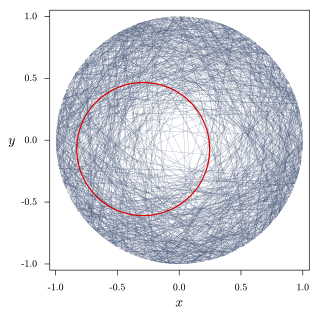 The same occurs for method 1, though it is harder to see in a graphical representation. Method 2 is the only one that is both scale invariant and translation invariant; method 3 is just scale invariant, method 1 is neither.
The same occurs for method 1, though it is harder to see in a graphical representation. Method 2 is the only one that is both scale invariant and translation invariant; method 3 is just scale invariant, method 1 is neither.
However, Jaynes did not just use invariances to accept or reject given methods: this would leave the possibility that there is another not yet described method that would meet his common-sense criteria. Jaynes used the integral equations describing the invariances to directly determine the probability distribution. In this problem, the integral equations indeed have a unique solution, and it is precisely what was called "method 2" above, the random radius method.
Probability theory
Probability theory is the branch of mathematics concerned with analysis of random phenomena. The central objects of probability theory are random variables, stochastic processes, and events: mathematical abstractions of non-deterministic events or measured quantities that may either be single...
. Joseph Bertrand introduced it in his work Calcul des probabilités (1888) as an example to show that probabilities may not be well defined if the mechanism or method that produces the random variable is not clearly defined.
Bertrand's formulation of the problem
The Bertrand paradox goes as follows: Consider an equilateral triangleTriangle
A triangle is one of the basic shapes of geometry: a polygon with three corners or vertices and three sides or edges which are line segments. A triangle with vertices A, B, and C is denoted ....
inscribed in a circle
Circle
A circle is a simple shape of Euclidean geometry consisting of those points in a plane that are a given distance from a given point, the centre. The distance between any of the points and the centre is called the radius....
. Suppose a chord
Chord (geometry)
A chord of a circle is a geometric line segment whose endpoints both lie on the circumference of the circle.A secant or a secant line is the line extension of a chord. More generally, a chord is a line segment joining two points on any curve, such as but not limited to an ellipse...
of the circle is chosen at random. What is the probability that the chord is longer than a side of the triangle?
Bertrand gave three arguments, all apparently valid, yet yielding different results.
- The "random endpoints" method: Choose two random points on the circumference of the circle and draw the chord joining them. To calculate the probability in question imagine the triangle rotated so its vertex coincides with one of the chord endpoints. Observe that if the other chord endpoint lies on the arc between the endpoints of the triangle side opposite the first point, the chord is longer than a side of the triangle. The length of the arc is one third of the circumference of the circle, therefore the probability that a random chord is longer than a side of the inscribed triangle is one third.
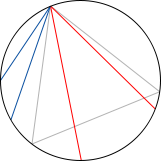
- The "random radius" method: Choose a radius of the circle, choose a point on the radius and construct the chord through this point and perpendicular to the radius. To calculate the probability in question imagine the triangle rotated so a side is perpendicular to the radius. The chord is longer than a side of the triangle if the chosen point is nearer the center of the circle than the point where the side of the triangle intersects the radius. The side of the triangle bisects the radius, therefore the probability a random chord is longer than a side of the inscribed triangle is one half.
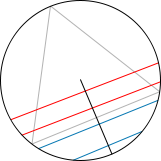
- The "random midpoint" method: Choose a point anywhere within the circle and construct a chord with the chosen point as its midpoint. The chord is longer than a side of the inscribed triangle if the chosen point falls within a concentric circle of radius 1/2 the radius of the larger circle. The area of the smaller circle is one fourth the area of the larger circle, therefore the probability a random chord is longer than a side of the inscribed triangle is one fourth.
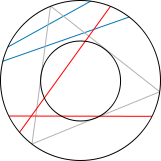
The selection methods can also be visualized as follows. A chord is uniquely identified by its midpoint. Each of the three selection methods presented above yields a different distribution of midpoints. Methods 1 and 2 yield two different nonuniform distributions, while method 3 yields a uniform distribution. On the other hand, if one looks at the images of the chords below, the chords of method 2 give the circle a homogeneously shaded look, while method 1 and 3 do not.
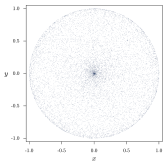 |
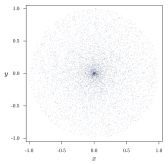 |
 |
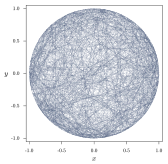 |
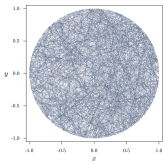 |
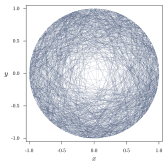 |
Other distributions can easily be imagined, many of which will yield a different proportion of chords which are longer than a side of the inscribed triangle.
Classical solution
The problem's classical solution thus hinges on the method by which a chord is chosen "at random". It turns out that if, and only if, the method of random selection is specified, the problem has a well-defined solution. There is no unique selection method, so there cannot be a unique solution. The three solutions presented by Bertrand correspond to different selection methods, and in the absence of further information there is no reason to prefer one over another.This and other paradoxes of the classical interpretation of probability justified more stringent formulations, including frequency probability
Frequency probability
Frequency probability is the interpretation of probability that defines an event's probability as the limit of its relative frequency in a large number of trials. The development of the frequentist account was motivated by the problems and paradoxes of the previously dominant viewpoint, the...
and subjectivist Bayesian probability
Bayesian probability
Bayesian probability is one of the different interpretations of the concept of probability and belongs to the category of evidential probabilities. The Bayesian interpretation of probability can be seen as an extension of logic that enables reasoning with propositions, whose truth or falsity is...
.
Jaynes' solution using the "maximum ignorance" principle
In his 1973 paper The Well-Posed Problem, Edwin Jaynes proposed a solution to Bertrand's paradox, based on the principle of "maximum ignorance"—that we should not use any information that is not given in the statement of the problem. Jaynes pointed out that Bertrand's problem does not specify the position or size of the circle, and argued that therefore any definite and objective solution must be "indifferent" to size and position. In other words: the solution must be both scale invariant and translation invariant.To illustrate: assume that chords are laid at random onto a circle with a diameter of 2, for example by throwing straws onto it from far away. Now another circle with a smaller diameter (e.g., 1.1) is laid into the larger circle. Then the distribution of the chords on that smaller circle needs to be the same as on the larger circle. If the smaller circle is moved around within the larger circle, the probability must not change either. It can be seen very easily that there would be a change for method 3: the chord distribution on the small red circle looks qualitatively different from the distribution on the large circle:

However, Jaynes did not just use invariances to accept or reject given methods: this would leave the possibility that there is another not yet described method that would meet his common-sense criteria. Jaynes used the integral equations describing the invariances to directly determine the probability distribution. In this problem, the integral equations indeed have a unique solution, and it is precisely what was called "method 2" above, the random radius method.

